The pistol squat is one of the hallowed movements among fitness lovers—especially bodyweight aficionados. While they’re not for everyone, if they’re in your repertoire you want them to be as clean as possible. A great pistol is smooth like a hot spoon through ice cream and effortless like this is how I always pick up my keys when I drop them. It is a classic demonstration of strength, balance, and mobility that is guaranteed to make you feel superhuman. Pistols require precise coordination of nearly every muscle in your body. Even advanced practitioners can feel sluggish, lopsided, or disharmonious as they move, especially at the bottom of the squat. These glitches can be corrected with some focused effort on what’s going on behind the scenes.
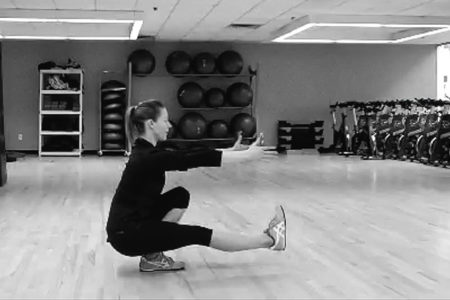
Hit the Bottom of the Pistol
If you’ve been training pistol squats for some time and you’re still stumped by the bottom range of motion (ROM), you’re not alone. Falling backward, tightness through the leg joints, loss of balance, and loss of confidence are all common puzzles for the would-be pistoler. In response to all four issues, there is a sketchy tactic that seems like a good solution but rarely is: the Slam ‘N’ Bounce. This is a high-speed drop which bounces your hamstrings against your calf to get past the sticking point. Moving fast might get you upright again, but training without addressing the problem is Sisyphean at best. Plus it skips the concept of skill mastery. Good news for Slam ‘N’ Bouncers who would like to get the rock to the top of the hill: you don’t have to sacrifice your knee and your strict pistol credibility to learn this lift. The way across the breach is through the elegance of physics, geometry, and biomechanics. Here are three simple corrections to help you cut the crusts off your stale pistol squat and feast on the delicious center instead.
Befriend the Low Single-leg Squat
Of all the things that can inhibit a clean pistol, simply being uncomfortable at the bottom range of motion is the most common. It’s a long way down, and many of your joints are moving quickly into compromised positions. As with any end-ROM work, your brain is the governor of the action and it will slam on the brakes if it is scared you’ll get hurt. This can not only lead to a reduction of ROM but also pain and loss of balance. Therefore, being comfortable with the low single-leg squat by itself is a requirement before trying to move into or out of it.
First try crouching down on two legs, and then shifting your weight onto one leg and see if you can steady yourself. Note: if you cannot get to a clean crouch on two feet, you probably have some work to do before attempting it on one foot. Checking your ankle and foot mobility is a good place to start. If your free-leg hip flexor gets cranky in this hyper-contracted position, you can put your heel on a furniture slider or towel and slowly slide the leg in and out. You’ll need to be able to pick it up eventually, but this is a good middle ground for practice.
Be patient while you experiment with this low hold. The bottom of a squat isn’t as biomechanically powerful as the middle of a squat so it isn’t supposed to feel that way. (Can you imagine Lebron sinking into a frog shape before taking a jump shot?) Don’t let the sensation of weakness at the bottom flummox you. Just because it’s less strong does not mean it’s not strong. The more time you spend down there the better you’ll understand where you are and aren’t yet capable.
Understand Your Tension Volume
The second mistake in pistol squatting is misunderstanding which parts of your body should be tense and which ought to be more relaxed. Logistically, it makes sense to try and squeeze your leg as hard as possible in order to generate the tension you need under load. But these social norms are better for pull-ups and deadlifts, whereas pistols prefer to be part of the counterculture. Rather than letting your lower body stiffen up, it’s your upper body which should be braced. This leaves your base leg more relaxed to fold up into live-action origami.
When you’re beginning the pistol, establish a strong front-to-back pull from your hips to your fingertips. This should happen before you ever start moving downwards because it will keep your center of mass right where you want it: centered. Most pistol disciples already understand that their hips must move backward, but many don’t realize that they need an equal and opposite reaction to the front. Reach your arms, shoulders, and even collarbones towards the wall in front of you, trying to touch it. Don’t reach for something ten feet away. Reach for twenty. You are searching for the sensation that your fingers and tailbone are in a tug of war, each pulling as hard as they can against the other. As you lower down, you’ll need to keep reaching your hands ever more forward, to continue counterbalancing your booty. If you do this properly, the end result will be a well-balanced torso, stabilized over the arch of the foot at every portion of the movement.
Synchronize Your Joint Action
The third mistake preventing you from a full ROM pistol is forgetting about joint rhythm. All of your joint movements should be synchronized, and errors usually happen when uncertainty creeps in. You might start aggressively folding at the hip, leaving your knee to catch up later. Or maybe you’re so focused on trying to sit back into your heel and glutes that you lose pressure between your toes and the floor. Don’t forget that your weight should sit in the center of the foot, not the heel—so you are using the springy arch to balance—and that it’s perfectly fine to let your knee come forward a bit over the toes. A well-executed squat should spread your foot bones and simultaneously flex (or extend) the ankle, knee, hip, spine, and shoulders. You will feel an equal pull and push in every one of these joints as you descend and ascend. The idea is that every joint’s ROM converges at the bottom and then diverges again as you return to standing. It’s this beautiful body folding which makes a pistol squat look effortless.
It is critical to move in a smooth, pain-free manner. If the bottom of your pistol squat feels tight or oblique, you’ll want to mitigate any threats on the way. If it’s simply that your leg tissues aren’t strong enough to handle a deep single-leg squat, try holding onto a fixed bar, a light kettlebell for a counterweight, or working the negative descent until you can lower yourself with control. These can all help your alignment stay on track while you develop the necessary strength.
If you’re limited by poor ankle or hip mobility, start developing those concurrently. The movement of the knee is global: the subtalar joint and the hip joint both contribute directly to knee function and dysfunction. You’ll need good ankle dorsiflexion and good hip adductor strength to complete a good pistol. As tempting as it may be, never force your joints through a restricted or painful ROM. As they (sort of) say, pride goeth before the degenerating medial meniscus.
Progress Your Pistol
As you understand your pistol squat better, you’ll start looking for ways to make it more difficult. The traditional approach is to systematically increase the weight you’re holding, and there is room for that in a program. However, after reaching a quality loaded pistol, I find the challenge of leverage changes to be smarter, safer, and more interesting than struggling to hoist a giant and gianter kettlebell to your chest. To change leverage, simply modify your arm position to mess with the front-to-back pull we discussed earlier. A small shift can make you feel like a beginner all over again. In increasing level of difficulty, try crossing your arms over your chest, clasping them behind your head, or even folding them behind your lower back. You will still need your push-pull tension through your upper body, but the moment arm will be altered (you’ll have less counterbalance), so don’t be surprised if you butt plant a few times while trying. And if you’d like to make any version of a pistol much harder, close your eyes. Make sure that you aren’t sacrificing fluid movement through the joints while scrapping to keep your balance.
Alongside technique, the preconditions for long-term pistol squat development are consistency and patience. Always give your body time to learn what you’d like it to do. Practice confidence in unfamiliar body positions, a strong and steady torso, and excellent balance. This increased self-awareness will help give you the pistol squat you’ve always dreamed of showing off.
Try these tips out and let us know how it goes in the comments below or in the StrongFirst online forum.
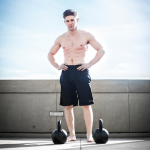
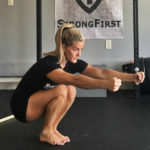
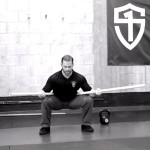
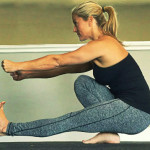
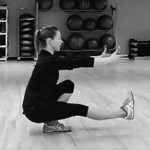

Well done! This is something that I’ve wanted to do and tried with little success — but I see (literally) that there is a physics behind the “how to”. Now to apply technique to me…. Thank you!
Thanks for this Mia: I found it clear, calmly inspiring and very useful.
Am working on my ankle dorsiflexion and can so far only achieve a wobbly pistol only on a sloping ground or in heeled shoes. Will try the upper body tension tip.
Hi Peter! Your ankle dorsiflexion may also improve just by virtue of improving your balance. (Working off your wobbly comment here.) The better balanced you are, the more willing your joints will be to move through full ROM. So don’t forget good balance drills. Good luck and thanks for reading!
🙂
Thank You, great tips: writeup and videos.
Thanks for reading! Hope it helps you perfectly finish up that pistol.
Well done, Mia!
Very useful and well-explained tips and videos.
I will play with some today :).
Thanks!
Thanks, Lance! Would love to hear a follow-up for how it went. Good luck!
What a great article!
Thank you, Mark! I appreciate the feedback 🙂
Very good article and video. Thank you
Thanks, Will! I appreciate you taking the time to read. Cheers to more beautiful pistols!